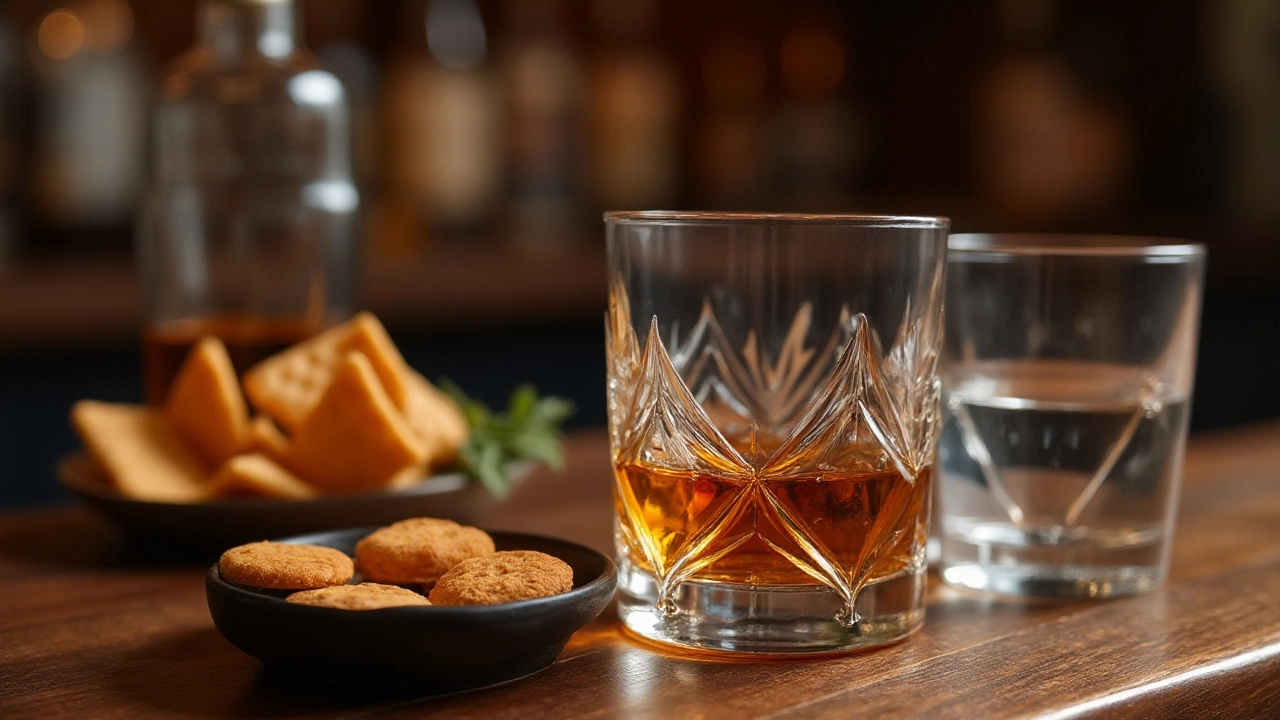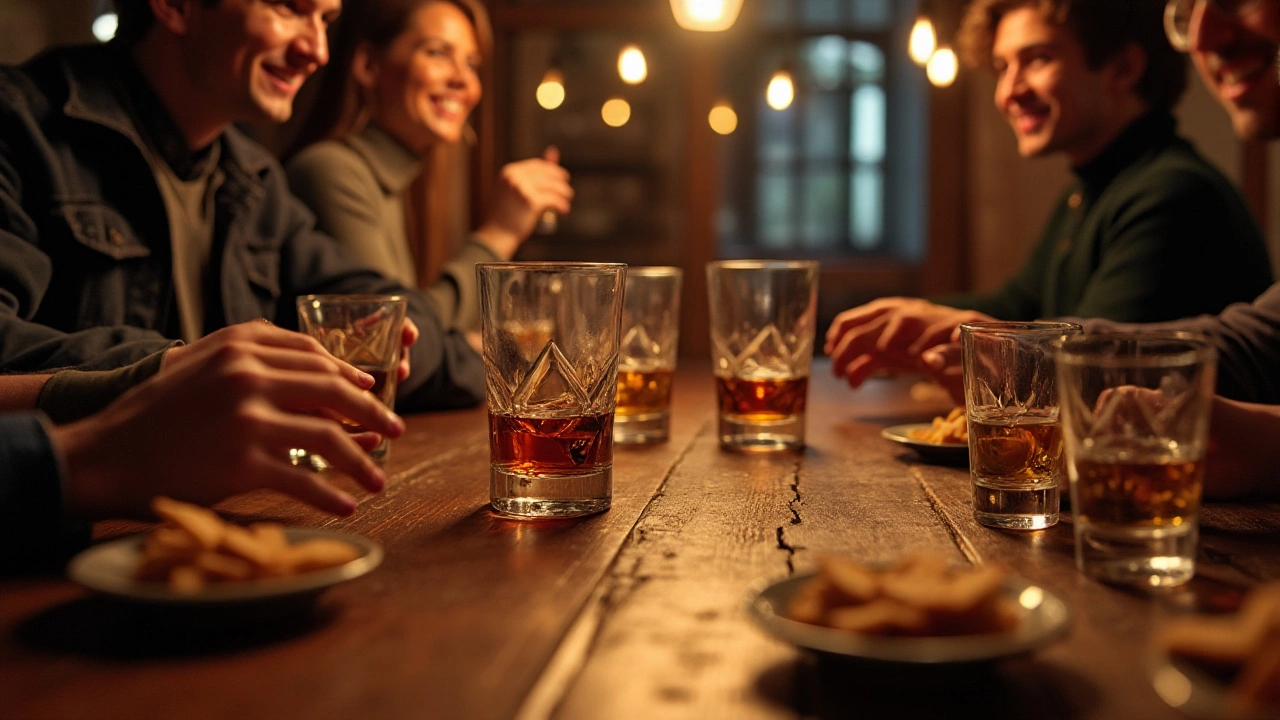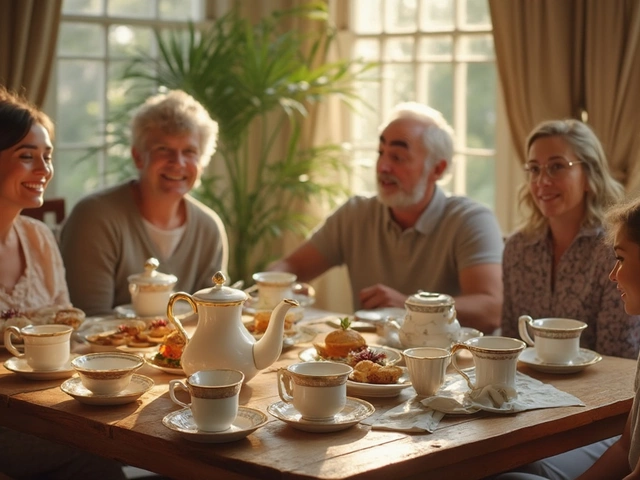When savoring a fine whiskey, the last thing you want is for lingering flavors from your previous sip to cloud your current experience. Whether you're a novice or a seasoned enthusiast, understanding how to cleanse your palate is a crucial step in truly appreciating the complexity of whiskey.
Much like an artist preparing a blank canvas, clearing your palate prepares your taste buds for the next tapestry of flavors. This involves more than just drinking water. From traditional crackers and water to unexpected helpers like sorbet, each method offers unique advantages.
This article dives into various approaches tailored for different levels of whiskey aficionados and shares tips on what not to do, ensuring your palate remains as discerning as possible. Begin your journey into an elevated whiskey tasting with fresh insights and practical advice that promise to enhance your sensory exploration.
- The Importance of Palate Cleansing
- Simple Cleansing Methods
- Advanced Techniques for Enthusiasts
- Common Mistakes to Avoid
- Scientific Insight on Taste Perception
- Transforming Your Tasting Experience
The Importance of Palate Cleansing
When you're on a journey through the rich landscapes of whiskey, your palate serves as the gateway to the entire experience. Without the proper measures to keep it clean and refreshed, the table upon which flavors are set can become cluttered and confused. Palate cleansing can significantly transform your flavor experience. Much like an instrument out of tune spoiling a symphony, an uncleansed palate can hinder the harmonious dance of whiskey's aromas and taste. Through palate cleansing, each sip resets the senses, readying them to explore the depths of the next pour with an untainted canvas. Recent studies have shown that varied flavors can linger on the taste buds, subtly altering perception, which makes cleansing an integral step in tastings.
"It's not just about getting a good taste, it's about allowing the whiskey to tell its story," said Gabriel Alden, renowned whiskey expert and author.
The act of cleansing can enhance not only the enjoyment but also the educational aspect of tastings. With each palate reset, the subtle nuances and hidden notes in a sample are more likely revealed. This isn't merely about eradicating the tastes of past sips but about preparing the taste buds to perceive the nuances with clarity and appreciation. Some aficionados mention discovering sweet hints or smoky undertones previously unnoticed when they regularly engage in effective cleansing. To achieve this, enthusiasts recommend mindful tasting, where palate cleansing should be rhythmically integrated, especially when navigating flights of distinctly different whiskeys.
Moreover, our taste perception is intertwined with psychological and sensory factors. The brain connects taste with memories or external stimuli, sometimes overpowering genuine flavors. Regularly cleansing helps maintain focus and ensures authenticity in each experience. As whiskey tastings grow in popularity, preparing and cleansing is becoming as much a social ritual as sipping itself. This appreciation for cleansing is mirrored in the meticulous preparation of tasting events where ritualistic cleansing methods are employed to accentuate the tasting narrative. This culture shift underscores the importance of starting each tasting moment afresh, enhancing not only personal enjoyment but also collective tasting endeavors.
Simple Cleansing Methods
Cleansing your palate during a whiskey tasting is akin to resetting a musical score—it provides the necessary foundation to appreciate each subsequent note in its fullest light. Water, heralded as the universal solvent, is perhaps the most straightforward and accessible means to accomplish this. When sipped at room temperature, water washes away not only the embedded flavors of previous sips but also hydrates the tongue, reinvigorating the papillae responsible for experiencing complex flavor profiles. A small sip followed by a swish is typically recommended in between tastings. Interestingly, some enthusiasts advocate for sparkling water, positing that carbonation serves to stimulate the taste buds while cutting through residual oils left by the whiskey.
In tandem with water, neutral-flavored foods like plain crackers or bread serve as traditional supplements in the palate cleansing arsenal. The dry texture of these foods can physically remove lingering flavors by absorbing oil and residue from the mouth. In organized tastings, you might often find a dish of unsalted crackers or a sliced baguette precisely for this reason. These snacks act as sponges, subtly neutralizing the mouth without imposing new flavors upon the palate. A fact worth mentioning is that activating different parts of your taste spectrum through such natural retunings helps maintain the integrity of each whiskey's distinct flavor.
For those who seek options beyond the familiar, room temperature green apples are frequently recommended. The mild acidity of the apple can refresh the palate by interacting with the taste buds at a chemical level. Its crispness offers an invigorating reset much milder than lemon, which can overwhelm and tamper with subsequent tastings. An alternative similar to apples is a bit of cucumber, offering crisp coolness with almost no interference in taste. Some seasoned tasters prefer its use due to its high water content and neutral nature.
Chemist Harold McGee, renowned for his works on food science, suggested that “Cleansing techniques are crucial in tasting sessions far more than one might initially speculate.” This emphasizes the integral role that these simple methods play in proficient sensory tasting practices.
Understanding what to avoid is as imperative as knowing what to employ. It’s advisable to steer clear of strong-flavored or sweet foods during tastings as these can strongly skew your sense of taste. Items like cheese, chocolate, or spicy appetizers can create an overwhelming sensory experience that disrupts the delicate flavors whiskey aficionados are seeking to discern. Remember, palate cleansing is all about clearing rather than layering more onto the taste experience.
A tasting session devoid of effective palate cleansing amounts to musical chaos—it’s those crucial pauses of neutrality that bring rhythm and clarity to a tasting. By employing such sensory practices, both simple and wise, you invite a deeper connection with every sip, promising an elevated appreciation for the crafted spirit that is whiskey.

Advanced Techniques for Enthusiasts
For those who have delved deeply into the world of whiskey tasting, taking palate cleansing to the next level can unlock even greater dimensions of flavor. While simple solutions work perfectly well, serious enthusiasts might consider adopting more advanced techniques to refine their sensory experience. One such method involves incorporating acidic elements, which can effectively reset the taste buds. Consider using a small wedge of green apple. The natural tartness acts as a great antidote to residual flavors, resetting your palate with a clean slate for your next sip.
Moreover, enzyme-rich foods can also play a pivotal role. Pineapples are not just tropical fruits that add zest to your summer cocktail but are quite effective due to the bromelain enzyme, which naturally cleanses and refreshes the mouth. It offers a surprisingly effective way to reset your senses in preparation for the intricate tasting notes in your next glass. Using these natural products can enhance the flavors you discover in the whiskey, providing a deeper understanding of what each bottle has to offer.
Experimenting with flavored sorbets, especially those made without dairy, is another innovative approach. Lemon or lime sorbets work exceptionally well to invigorate the palate, helping you to perceive the subtler notes in whiskey that might otherwise go unnoticed. The chilled sorbet refreshes not only your taste buds but also your sense of smell, which is integral to savoring the full spectrum of whiskey’s complex aromas. This technique is especially useful during whiskey tasting events, where multiple samples require the palate to remain fresh.
An intriguing piece of advice for experienced tasters comes from Richard Paterson, a renowned whisky master blender, who suggests smelling coffee grounds between tastings. He remarked, "Coffee has a remarkable ability to cleanse the nasal palate, much like its effect on the olfactory senses when smelling perfumes." You can use this trick to recalibrate your senses, ensuring that each glass of whiskey tells its own story without the interference of the previous one.
As an enthusiast, another strategy that can significantly improve your tasting experience is proper hydration. Water acts as a universal palate cleanser, but for advanced tasters, mineral water with a neutral pH level is recommended because its balance helps keep the mouth in a receptive state. This is particularly crucial when tasting high ABV whiskies, which can numb the palate over successive sips. Staying hydrated maintains your sense of taste and helps to unlock the layered flavors hidden in each whiskey.
Introducing palate cleansers in a structured way, much like a ritual, can heighten their effectiveness. After each tasting, make it a point to cleanse your mouth lightly, then take a few deep breaths. This allows both the mind and senses to align, creating a more focused and contemplative tasting session. As science backs up, the practice of deep breathing also helps in reducing flavor fatigue, making every sip a new experience altogether.
Common Mistakes to Avoid
Embarking on a whiskey tasting journey is like stepping into a world filled with nuanced aromas and elaborate flavors. However, the experience can quickly turn sour if you're making common palate-cleansing mistakes. One of the most overlooked errors is relying solely on water to reset your taste buds. While water is vital in clearing residual flavors, it might not be enough for truly robust or heavily peaty whiskeys. A key strategy for achieving a cleaner slate is balancing water with neutral-tasting snacks such as plain bread or unsalted crackers, offering a more thorough cleanse without introducing new flavors.
Another surprising misstep is underestimating the impact of certain foods prior to tasting. Garlic, onions, and spicy foods can linger for hours, profoundly affecting your ability to discern subtle whiskey notes. Ensure that these potent flavors are avoided before a tasting session. It is also wise to avoid strong-smelling environments, like a kitchen where meals are being prepared. These aromas can compete with the whiskey’s bouquet, hence blurring the sensory experience it offers.
"The palate is a delicate instrument, easily influenced by its environment and what you put on it," says renowned whiskey critic, Michael Jackson.
A frequent mistake among whiskey enthusiasts is palate cleansing with sugary or spicy foods during the tasting process. It's best to steer clear of these options, as sugar can coat the tongue, and spices can temporarily numb taste receptors, impacting your sensitivity to flavors. Instead, some experts suggest using green apples or sorbet in between tastings, as these offer a crisp, clean palate without obtrusive aftertaste. This approach respects the art of sensory preparation while enhancing the enjoyment of subsequent whiskey presentations.
Timing can also be a critical error. Swifting between flavors without giving yourself proper time to acclimate can cause overlap and confusion of tastes. Experts recommend pausing for at least 5 to 10 minutes between different whiskeys. This break allows your senses to reset naturally, making the next glass more enjoyable. A practiced palate reset could swiftly become your secret weapon during whiskey tasting events, transforming each sip into an exploration.
Finally, measuring consumption is vital yet often misjudged. Sampling excessively in one session numbs your taste buds, diminishing your ability to appreciate each whiskey’s particular characteristics. Engaging in periodic assessments with small pours avoids overwhelming your senses and maintains a consistent focus on flavor appreciation. Remember, quality surpasses quantity in whiskey tasting, and this practice safeguards the integrity of your palate.

Scientific Insight on Taste Perception
Delving into the science behind taste perception can enrich your whiskey tasting journey by offering a deeper understanding of what happens when whiskey meets your taste buds. Human taste buds, numbering around 10,000, are not randomly distributed; they cluster in specific zones on your tongue, each possessing sensitivity to distinct taste categories such as sweet, salty, sour, bitter, and umami. The dynamics of these taste buds play a critical role in the perception of flavors. When you consume whiskey, the volatile compounds interact with these receptors, sending signals to your brain that it interprets as taste. This sensory information doesn't act in isolation, but rather is influenced by smell, texture, and even the psychological context of your tasting environment.
Your olfactory senses, in particular, are integral to the full sensory completion of taste. It's often stated that a significant portion of what we perceive as taste is actually derived from our sense of smell. This is why professional tasters will often take in a slow, deep sniff of whiskey, allowing the aromas to linger before they let the liquid touch their lips. The combination of this olfactory information with taste signals creates the complex flavor profiles we associate with different whiskeys. A fun fact for enthusiasts: a study from the Monell Chemical Senses Center suggests that your genes play a role in how we perceive flavors, meaning your own taste perception is uniquely yours.
“One cannot think well, love well, sleep well, if one has not dined well.” — Virginia Woolf
Engaging with the sensory elements extends beyond purely physiological responses, venturing into the realm of the psychological. The ambience of the tasting environment, the presence of friends, and even your mood can alter how flavors are perceived. Drinking whiskey in a calm, comfortable setting can enhance not just enjoyment, but perceptual acuity as well. It's an interplay between the senses and the mind — a dance of expectation and experience that shapes how we appreciate each sip. Therefore, when experimenting with ways to cleanse your palate, it's beneficial to consider not only the physical cleansers, like water and bland crackers, but also creating an ideal tasting atmosphere that is as much about visual and auditory comfort as it is about olfactory clarity.
Transforming Your Tasting Experience
Immersing yourself in the world of whiskey tasting is akin to embarking on a journey where each sip tells a different story. To truly transform your tasting experience, one must delve deeper than simply appreciating the basics of aroma, taste, and texture. Engaging all senses, enthusiasts often find that enhancing their palate cleansing routine significantly elevates their appreciation of distinct whiskey flavors. By resetting your taste buds effectively, you're not just preparing for the next sip; you're setting the stage for an array of flavor spectrums to unfold. Whether you're enjoying a rich bourbon or a peaty Scotch, ensuring your palate is pristine sharpens your perception, allowing subtle nuances and complexities to come to life as though you've never tasted them before. Several traditional and modern methods can be employed to achieve this high level of taste clarity, each contributing to a fresher, more vibrant tasting session.
Researchers have long been fascinated by how certain foods and drinks affect our taste perceptions during whiskey tasting. For instance, raw ginger is praised not only by the whiskey tasting community but also by studies that have shown its effective properties in neutralizing the palate. Another classic method is sipping water to clear any remnants, often combined with plain crackers or bread. These basic tools act like a painter's brush, ensuring the palate remains vibrant and unobstructed by competing flavors. As whiskey experiences become more cultivated, enthusiasts are turning to more refined palate cleansers like lightly salted almonds or a sorbet infused with citrus, designed to balance the palate efficiently without overwhelming it.
Understanding the chemistry behind taste perception can push your whiskey tasting adventures even further. A study published in the Journal of Sensory Studies highlights how certain hydrophobic molecules interact with taste receptors to dull sensations, indicating the importance of thorough cleansing between tastings. Each approach to palate cleansing brings different benefits, tailored to the whiskey type and the drinker's personal flavor sensitivity. For example, pairing a woodsy whiskey with unsalted nuts can help reset the taste while enhancing the inherent earthy notes. With a disciplined approach to palate cleansing, the whiskey transforms in complexity, offering a symphony of flavors that might otherwise go unnoticed.
Transforming your tasting experience isn't merely about the method; it's also about the mindset. Embracing each glass as a narrative means you're not rushing through but instead savoring each sip with intention. As whiskey specialist Jim Murray once noted, "Whiskey is a sensory experience beyond just taste; it engages your emotional and mental faculties."
"Pay attention not just to the alcohol content," he advises, "but to how each whiskey's unique character resonates with you personally."By adopting a meticulous approach to palate cleansing, you're not just reaching for a higher plateau of tasting but forging a deeper connection with every bottle, allowing for a more nuanced and rewarding exploration of whiskey.


